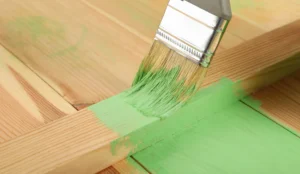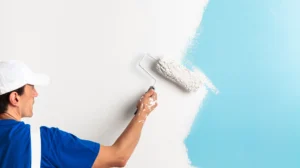
Best Paint for Wood
Painting wood protects it from the elements, from cracking and seals it so it ages well. Depending on if the wood is interior or exterior,
Mold can be commonly found in damp areas like basements, bathrooms and garages. Left unchecked, it can work its way into drywall and flooring, causing expensive damage that has to be repaired for your family’s health.
However, there are some paint types that can suppress new mold growth by using an antimicrobial mixture. However, any existing mold or mildew needs to be remediated prior to painting as the spores will make their way through the paint.
Mold and mildew occur most often in consistently damp areas, like bathrooms, basements, mud rooms and more. The right primer and paint can prevent new mold from forming, but it can’t kill existing mold.
Mold spores are all around us, but they can’t grow in dry conditions, so they stay dormant. In a damp area, such as wet drywall in a bathroom, mold can take hold if the relative humidity stays above 55 percent for any length of time.
Imagine you have a damp area in your bathroom that never really dries out. Without running a fan or
Mildew is also a type of fungus, but it’s generally easier to eliminate than mold. Mold can be black, pink, green, blue and red while mildew is always white. Once mold gets into drywall, wood or fabrics, it needs specialized treatment to remove it.
For small moldy areas, a solution of bleach and water can be applied to the mold to kill it. Black mold is more dangerous and requires a specialist. Always take care when handling bleach and don’t mix it with other cleaning solutions.
Once you have a clean, mold-free surface, then you’ll get the best results when painting.. Painting a dry surface with no mold means that the paint can seal the surface, allowing no new moisture in. For items like wood or drywall, painting them can act as an insulating, protective coat that keeps moisture out while providing aesthetic value.
When selecting a paint to suppress future mold growth, look for primers and paints that say they have antimicrobial properties. This solution, when added to paint, helps prevent new mold spores from getting established on the painted areas.
Vista Paint recommends, for high-traffic areas, 7001 Acriglo Interior Primer. This acrylic primer is low-VOC, making it ideal for interiors since it will have minimal offgassing once it dries. Low-VOC paints don’t require as much ventilation and cure quickly. This primer resists the growth of microbes, meaning it’s suitable for high-traffic spots and commercial use as well as persistently damp areas.
Remember to prime the surface carefully and follow the instructions on the paint. Primer should only go onto a dry, clean surface with no mildew or mold. You may need to apply two layers of primer depending on the color of the paint or the condition of the wall. Primer’s purpose is to cover old paint and provide an even surface by filling in gaps and bubbles in wall texture. This gives the paint a strong finish to adhere to.
To cover this primer, the 7000 Acriglo Semi-Gloss and 7100 Acriglo Flat are ideal choices. Both are also low-VOC and contain antimicrobial products for the surface of the paint. Again, no paint can suppress existing mold or mildew, but in a sanitized area, these paints will resist new mold growth even in damp areas.
8500 Carefree Gloss has an enamel finish for interior and exterior use. It suppresses the growth of microbes and is safe for use in food-preparation areas. Enamel provides a shell-like exterior that dries hard, giving it a classic look. Enamel paint also has remarkable durability and a beautiful finish.
It also comes in a Semi-Gloss and Gloss, but these should not be used in food preparation areas. They also have the technology needed to suppress microbial growth. Higher gloss paints are easier to clean and ideal for trims, doors and other high-touch areas.
If you’re choosing paint for exterior use, the 2000 Duratone is an exterior acrylic flat paint that provides superior mildew resistance. It’s recommended that you prime exterior surfaces correctly. This involves selecting the right primer and painting only when the surface is dry.
Vista Paint’s 3000 Acribond is a superior choice for exterior use. This acrylic solid stain can be white, tinted or custom colored for full coverage of wood, masonry, primed concrete and metal. It resists mildew growth, which makes it ideal for areas that are consistently damp or in the shade.
Painting a wet surface will lock in mold spores and mildew, so the end result won’t look good. Remember to prepare the area by cleaning it and treating all mold and mildew. Once it’s ready to paint, you can prime with one of the recommended primers before painting.
One benefit of using a mildew-resistant paint is that it’s easy to clean and maintain. A surface painted with high-quality paint can hold up to scrubbing or cleaning as needed. The paint also protects the wood and drywall underneath, making it easy to maintain.
With the right paints applied and mold treated successfully, preventing future mold growth is key to making sure your paint stays beautiful. In indoor areas, selecting a mildew- and mold-resistant paint helps by reducing the chances that mold can get established.
Use fans or dehumidifiers if necessary to keep humidity in a confined space below 55 percent. In outdoor areas, a dark and damp corner may be more prone to mildew and mold growth. While the right paint will help resist mold growth, you may get algae, which is an entirely different organism. This can be brushed off with a scrub brush or power washed off, but make sure if you’re using a power washer to select a setting that won’t also remove paint.
By treating any mold and mildew and choosing the right paints and primers, you can suppress mold growth and keep your painted surfaces looking as beautiful as the day you painted them.

Painting wood protects it from the elements, from cracking and seals it so it ages well. Depending on if the wood is interior or exterior,

Have you ever tried to paint a home that was covered in incredibly busy wallpaper? (To envision this, think of the décor and wallpaper at

You’ve just been through a big move after spending weeks packing and organizing. However, you won’t be able to feel happy and comfortable in your

Painting wood protects it from the elements, from cracking and seals it so it ages well. Depending on if the wood is interior or exterior,

Have you ever tried to paint a home that was covered in incredibly busy wallpaper? (To envision this, think of the décor and wallpaper at
© 2025 Vista Paint Corporation